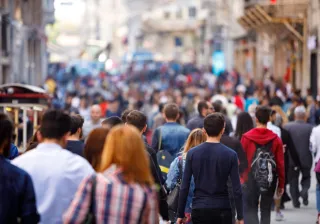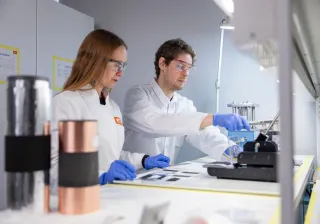The smart city of the future will be crammed with technology harnessed for a single purpose: to make us happy. Technology will also be needed to solve urban environmental problems and halt climate change.
Over half of the world's population already lives in cities. The figure will be over 70% by 2050.
– People come to cities to realise their dreams, to live a good life, says Antti Ruuska, a Co-creation Manager at VTT.
The theme of the VTT Growth Lab held for stakeholders in August 2018 was 'Good Life'. This is one of the five societal challenges that VTT is tackling through its activities.
The attractiveness of cities is based on the opportunities they provide. Cities offer the best opportunities for work, hobbies and starting a family. However, with their difficult environmental problems, many of the world's cities are far from what might be called a good living environment. Rapid growth is not easing the problem.
– My two-year-old son will be my age in 2050, when the world's cities are home to 2.5 billion more people than now, says Ruuska at the Growth Lab event.
– They need homes, schools, hospitals and services. The building of infrastructure is a major challenge, given the world's finite resources and the simultaneous need to halt climate change.
The Smart City will change everything
The term Smart City refers to a change in which people's quality of life in the cities improves while the environmental burden is lightened – thanks to new technology.
Antti Ruuska believes that many Smart City development projects should be much more ambitious. New technology alone will not suffice. If urban waterways are contaminated and air quality poor, residents will have little use for the data in question. Not even if a technically advanced sensor network generates data and transmits it in real time to a mobile application.
– The genuinely smart approach is to tackle the causes of problems and use technology to help solve them.
A range of challenges is involved when the needs of a growing urban population must be met sustainably. How do we break industrial waste cycles, switch to bio-based products, make food production sustainable, clean up the air and waterways, and make urban nature flourish?
Partial solutions towards a great goal
Technology is a tool for solving these problems, but the main objective should be to guarantee a good life.
– Of course, not everything can be changed at once. But even small, partial solutions should be part of achieving this great goal. For example, in the long run a robotic bus experiment could be the first step towards making public transport zero-emission, clean and automated.
A variety of smart city projects involving the testing of new technologies are being launched in urban environments around the world. Ruuska points out that many pilots are hampered by not including service users in the development process.
Smart Otaniemi for energy business of the future
A different approach to the issue is being taken by the Smart Otaniemi project underway on VTT's home campus.
– This involves a large number of companies with which we are working to create an energy business of the future. In the next phase of the project, together with residents we will explore the role energy plays in their daily lives.
The traditional product development cycle involves the development of one or two products a year. Only then are demand for the product and the opinions of users assessed. The idea behind the Smart Otaniemi project is to develop future energy services alongside users from the outset.
– By seeking feedback at the conceptual stage and experimenting together, we can direct product development towards products and services that are relevant to customers.
– With respect to smart cities, we need to discuss solutions that foster a good life. The technology is a secondary issue. It is there to solve problems and make us happy, says Antti Ruuska.
Revision of good life indicators
To many people, a good life means many spacious houses, fine cars and delicious dinners.
– But, in the long run, this is not possible for everyone in the world. To create a good life sustainably, we have to take account of the scarcity of resources, says Antti Ruuska.
The great challenge for the cities of the future lies in using scarce resources more efficiently. At the Growth Lab customer event, Ruuska presented an illustrative example from Espoo. This city of 272,000 inhabitants is growing by almost 5,000 residents a year. New homes will be needed for nearly 50,000 inhabitants in just ten years – or will they?
What if we gave up a few square metres of space and returned to, say, the 1990s level of 31 square metres per resident? In such a case, Espoo would get through the next 10 years with its current building stock, without a single new home.
– Is floor space a good measure of the good life? I think that it is not. If a lot of functions could be outsourced, homes would not need to be so large.
There is a range of services in cities, from goods storage to communal saunas. In addition, more floor space is expensive. Is it worth investing EUR 5,000/m2 in a hobby room or home theatre, when you can access them as services whenever you want?
– There is enormous potential for enhancing the use of floorspace, says Ruuska.
His own workstation is a live example of this. Ruuska spends his working hours in meetings and on customers' premises.
– I probably spend less than 10% of my working time at my own workstation.
A good example of the new thinking is the SSA-Hotel on Mannerheimintie street in Helsinki, where you can buy a room of your own and rent it out to others when you don't need it.
Antti Ruuska is particularly fond of the hotel's solution for using space.
– The rooms are offices during the day and hotel rooms at night. In principle, only one building is needed instead of a separate hotel and office complex.
The same kind of unconventional thinking is represented by Espoo's award-winning 'School as a Service' concept, based on which Espoo upper secondary schools move onto the Otaniemi Aalto University campus while their own buildings are being renovated.
At best, resource-wise urban life benefits both individuals and society. For example, well-functioning public transport could free people from the need to own cars.
– It is often thought that people leave their cars at home because they are ready to make sacrifices. But the choice is easy when a more sustainable solution is also more convenient and cheaper, says Ruuska.
Data at the core
Data and its clever use lie at the heart of the smart and resource-efficient city of the future. Ruuska points out that a thoroughgoing, value-based discussion lies ahead with regard to the limits on data use.
Some of the cleverest people in the world work for companies like Google, Apple, Facebook and Alibaba – gathering information about us. This information is mainly used to sell more goods to consumers. We have already opened up our personal data to advertisers. However, to achieve a good life, a more meaningful use of such data would be in robotic preventive healthcare, for example.
– Would we be prepared to lose a little privacy if technology could reveal and treat a hidden disease in one of us, or a relative? Ruuska wonders.
Tackling the fundamentals
Antti Ruuska already has a career of almost ten years behind him at VTT, as a researcher and then a business developer. His current title is Co-creation Manager.
– Problems such as climate change are also great opportunities, but no one can solve such problems alone. My job involves enabling cooperation between businesses, research organisations and service users, and ensuring that this creates value for everyone.
Antti Ruuska is particularly enthusiastic about VTT's new slogan "Beyond the obvious". That is just what he is aiming at in his own work.
– It's about wondering together what we could achieve if we tackle the fundamentals of a problem rather than doing what is most obvious.





